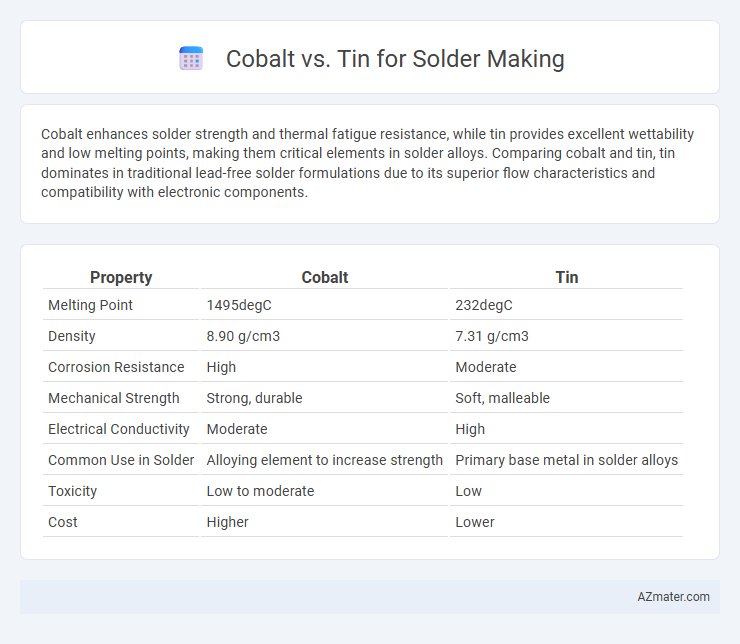Cobalt enhances solder strength and thermal fatigue resistance, while tin provides excellent wettability and low melting points, making them critical elements in solder alloys. Comparing cobalt and tin, tin dominates in traditional lead-free solder formulations due to its superior flow characteristics and compatibility with electronic components.
Table of Comparison
| Property | Cobalt | Tin |
|---|---|---|
| Melting Point | 1495degC | 232degC |
| Density | 8.90 g/cm3 | 7.31 g/cm3 |
| Corrosion Resistance | High | Moderate |
| Mechanical Strength | Strong, durable | Soft, malleable |
| Electrical Conductivity | Moderate | High |
| Common Use in Solder | Alloying element to increase strength | Primary base metal in solder alloys |
| Toxicity | Low to moderate | Low |
| Cost | Higher | Lower |
Introduction to Solder Materials: Cobalt and Tin
Cobalt and tin are essential materials in solder making, where tin serves as the primary base metal due to its low melting point and excellent wetting properties. Cobalt is often added in small amounts to enhance mechanical strength, corrosion resistance, and thermal stability in solder alloys. The combination of tin's solderability and cobalt's durability results in reliable, high-performance joints in electronics manufacturing.
Chemical Properties: Cobalt vs Tin
Cobalt exhibits a higher melting point (1495degC) compared to tin (232degC), making it more suitable for high-temperature solder alloys. Chemically, cobalt resists oxidation and corrosion better than tin, enhancing solder joint durability in harsh environments. Tin's low melting point and excellent wetting characteristics enable easy flow and strong adhesion on metal surfaces in traditional solder applications.
Melting Points and Thermal Performance
Cobalt has a melting point of approximately 1495degC, significantly higher than tin's melting point at 232degC, making cobalt unsuitable as a primary solder material but valuable as an alloying element to enhance joint strength. Tin's lower melting point allows for easy reflow and efficient thermal performance in soldering, supporting rapid heat transfer and minimizing thermal stress on components. Thermal performance in solder alloys is largely influenced by tin content, while cobalt additives improve mechanical durability without compromising the solder's melting behavior.
Electrical Conductivity Comparison
Tin exhibits higher electrical conductivity compared to cobalt, making it more suitable for soldering applications where efficient electrical flow is critical. Cobalt, while offering superior mechanical strength and corrosion resistance, has significantly lower electrical conductivity, which can impede the performance of solder joints in electronic circuits. The typical conductivity of tin is around 9.17 x 10^6 S/m, whereas cobalt's conductivity is approximately 1.7 x 10^6 S/m, reflecting a substantial difference in their capacity to conduct electricity.
Corrosion Resistance and Durability
Cobalt-enhanced solder alloys exhibit superior corrosion resistance compared to traditional tin-based solders, minimizing oxidation and degradation in harsh environments. The addition of cobalt improves the mechanical strength and thermal stability of the solder joint, enhancing overall durability during thermal cycling and mechanical stress. Tin-based solders, while widely used for their excellent wetting properties and electrical conductivity, tend to corrode faster and degrade under prolonged exposure to moisture and corrosive agents.
Solderability and Wettability Differences
Cobalt in solder alloys enhances mechanical strength but tends to reduce solderability due to its higher melting point and limited wettability on copper substrates, leading to less efficient joint formation. Tin, a primary component in most solders, provides excellent solderability and wettability with metals like copper and nickel, ensuring strong metallurgical bonds and uniform spread. The balance between cobalt's mechanical benefits and tin's superior wetting characteristics is critical in optimizing solder alloy performance for electronics manufacturing.
Environmental and Health Considerations
Cobalt used in solder making poses significant health risks due to its potential to cause respiratory issues and skin sensitization, necessitating strict handling protocols, while tin is generally considered safer with lower toxicity levels. Environmental concerns of cobalt include its mining impacts, such as habitat destruction and water contamination, whereas tin offers a relatively lower environmental footprint but may involve toxic byproducts during smelting. Sustainable solder production increasingly favors tin-based alloys to minimize ecological harm and protect worker health without compromising solder quality.
Cost and Availability in the Market
Cobalt is significantly more expensive and less abundant than tin, driving up the cost of solder alloys that incorporate it. Tin remains the primary base metal for solder due to its widespread availability and lower price, making it the more cost-effective choice for large-scale manufacturing. Market fluctuations in tin supply can impact prices, but cobalt's niche demand and scarcity keep its cost consistently higher.
Common Applications: Cobalt-Based vs Tin-Based Solders
Cobalt-based solders excel in applications requiring high strength and wear resistance, such as aerospace and automotive electronics, due to their superior mechanical properties and thermal stability. Tin-based solders dominate mainstream electronics assembly, offering excellent electrical conductivity and ease of use in printed circuit boards and consumer electronics. The choice between cobalt and tin solder is driven by specific application demands, balancing performance requirements with cost and compatibility factors.
Conclusion: Choosing the Best Metal for Solder Making
Cobalt offers superior mechanical strength and higher melting points, making it ideal for applications requiring robust, high-temperature solder joints. Tin provides excellent wettability and corrosion resistance, ensuring reliable electrical connections in most standard electronics. Selecting the best metal depends on specific project requirements, with cobalt favored for durability and tin preferred for general-purpose soldering.

Infographic: Cobalt vs Tin for Solder making
 azmater.com
azmater.com